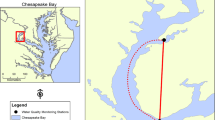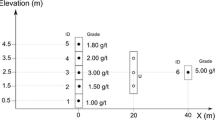Abstract
A key issue to address in synthesizing spatial data with variable-support in spatial analysis and modeling is the change-of-support problem. We present an approach for solving the change-of-support and variable-support data fusion problems. This approach is based on geostatistical inverse modeling that explicitly accounts for differences in spatial support. The inverse model is applied here to produce both the best predictions of a target support and prediction uncertainties, based on one or more measurements, while honoring measurements. Spatial data covering large geographic areas often exhibit spatial nonstationarity and can lead to computational challenge due to the large data size. We developed a local-window geostatistical inverse modeling approach to accommodate these issues of spatial nonstationarity and alleviate computational burden. We conducted experiments using synthetic and real-world raster data. Synthetic data were generated and aggregated to multiple supports and downscaled back to the original support to analyze the accuracy of spatial predictions and the correctness of prediction uncertainties. Similar experiments were conducted for real-world raster data. Real-world data with variable-support were statistically fused to produce single-support predictions and associated uncertainties. The modeling results demonstrate that geostatistical inverse modeling can produce accurate predictions and associated prediction uncertainties. It is shown that the local-window geostatistical inverse modeling approach suggested offers a practical way to solve the well-known change-of-support problem and variable-support data fusion problem in spatial analysis and modeling.



Similar content being viewed by others
References
Atkinson PM, Jeganathan C (2010) Estimating the local small support semivariogram for use in super-resolution mapping. In: Atkinson PM, Lloyd CD (eds) geoENV VII—geostatistics for environmental applications. Springer, Berlin, pp 279–294
Atkinson PM, Tate NJ (2000) Spatial scale problems and geostatistical solutions: a review. Prof Geogr 52(4):607–623
Chilès J, Delfiner P (2012) Geostatistics: modeling spatial uncertainty, 2nd edn. John Wiley & Sons Inc., Hoboken
Cressie N (1996) Change of support and the modifiable areal unit problem. Geogr Syst 3(2–3):83–101
Cressie N, Johannesson G (2008) Fixed rank kriging for very large spatial data sets. J R Stat Soc B 70(1):209–266
Cressie N, Shi T, Kang E (2010) Fixed rank filtering for spatial-temporal data. J Comput Graph Stat 19(3):724–745
D’Hondt O, López-Martínez C, Ferro-Famil L, Pottier E (2007) Spatially nonstationary anisotropic texture analysis in SAR images. IEEE Trans Geosci Remote Sens 45(12):3905–3918
Gelfand AE, Zhu L, Carlin BP (2001) On the change of support problem for spatio-temporal data. Biostatistics 2(1):31–45
Goovaerts P (2006) Geostatistical analysis of disease data: accounting for spatial support and population density in the isopleth mapping of cancer mortality risk using area-to-point Poisson kriging. Int J Health Geogr. doi:10.1186/1476-072X-5-52
Goovaerts P (2008) Kriging and semivariogram deconvolution in the presence of irregular geographical units. Math Geol 40(1):101–128
Gotway CA, Young LJ (2002) Combing incompatible spatial data. J Am Stat Assoc 97(458):632–648
Gotway CA, Young LJ (2005) Change of support: an interdisciplinary challenge. In: Renard P, Demougeot-Renard H, Froidevaux R (eds) Geostatistics for environmental application. Springer, Berlin, pp 1–13
Gotway CA, Young LJ (2007) A geostatistical approach to linking geographically aggregated data from different sources. J Comput Graph Stat 16(1):115–135
Hammerling DM, Michalak AM, O’Dell C, Kawa SR (2012) Global CO2 distributions over land from the greenhouse gases observing satellite (GOSAT). Geophys Res Lett 39:L08804. doi:10.1029/2012GL051203
Hass TC (1990) Lognormal and moving window methods of estimating acid deposition. J Am Stat Assoc 85(412):950–963
Higdon DM, Swall J, Kern J (1999) Nonstationary spatial modeling. In: Bernardo JM, Berger JO, Dawid AP, Smith AFM (eds) Bayesian statistics 6. Oxford University Press, Oxford, pp 1–9
Huang HC, Cressie N, Gabrosek J (2002) Fast resolution-consistent spatial prediction of global processes from satellite data. J Comput Graph Stat 11(1):1–26
Kelsall J, Wakefield J (2002) Modeling spatial variation in disease risk: a geostatistical approach. J Am Stat Assoc 97(459):692–701
Kitanidis PK (1995) Quasi-linear geostatistical theory for inversing. Water Resour Res 31(10):2411–2419
Kyriakidis PC, Yoo E (2005) Geostatistical prediction and simulation of point values from areal data. Geogr Anal 37(2):124–151
Michalak AM, Bruhwiler L, Tans PP (2004) A geostatistical approach to surface flux estimation of atmospheric trace gases. J Geophys Res 109:D14109. doi:10.1029/2003JD004422
Mugglin AS, Carlin BP (1998) Hierarchical modeling in geographic information systems: population interpolation over incompatible zones. J Agric Biol Environ Stat 3(2):117–130
Müller HG, Stadtmüller U, Tabnak F (1997) Spatial smoothing of geographically aggregated data, with application to the construction of incidence maps. J Am Stat Assoc 92(437):61–71
Nguyen H, Cressie N, Braverman A (2012) Spatial statistical data fusion for remote sensing applications. J Am Stat Assoc 107(499):1004–1018
Openshaw S, Taylor P (1979) A million or so correlation coefficients: three experiments on the modifiable areal unit problem. In: Wrigley N (ed) Statistical Methods in the Spatial Sciences. Pion Ltd, London, pp 127–144
Paciorek CJ, Schervish MJ (2006) Spatial modeling using a new class of nonstationary covariance functions. Environmetrics 17(5):483–506
Pardo-Igúzquiza E, Chica-Olmo M, Atkinson PM (2006) Downscaling cokriging for image sharpening. Remote Sens Environ 102(1–2):86–98
Snodgrass MF, Kitanidis PK (1997) A geostatistical approach to contaminant source identification. Water Resour Res 33(4):537–546
Tarnavsky E, Garrigues S, Brown ME (2008) Multiscale geostatistical analysis of AVHRR, SPOT-VGT, and MODIS global NDVI products. Remote Sens Environ 112(2):535–549
Tobler W (1979) Smooth pycnophylactic interpolation for geographical regions. J Am Stat Assoc 74(367):519–536
Wikle CK (2010) Low-rank representation for spatial processes. In: Gelfand AE, Diggle P, Guttorp P, Fuentes M (eds) Handbook of spatial statistics. CRC Press, New York, pp 107–118
Wikle CK, Milliff RF, Nychka D, Berliner LM (2001) Spatio-temporal hierarchical Bayesian modeling: tropical ocean surface winds. J Am Stat Assoc 96(454):382–397
Yoo EH, Kyriakidis PC (2006) Area-to-point kriging with inequality-type data. J Geogr Syst 8(4):357–390
Yoo EH, Kyriakidis PC (2009) Area-to-point kriging in spatial hedonic pricing models. J Geogr Syst 11(4):381–406
Zhou Y, Michalak AM (2009) Characterizing attribute distributions in water sediments by geostatistical downscaling. Environ Sci Technol 43(24):9267–9273
Acknowledgments
The work was conducted with the financial support from the Shenzhen Oversea Talent Program of Technical Innovations (KQCX2014052114595626) and the National Natural Science Foundation of China (41401215). The authors would like to thank Dr. Emily Kang from University of Cincinnati for providing the sample codes related to fixed rank kriging. The authors also thank the anonymous reviewers for their constructive comments on the manuscript.
Author information
Authors and Affiliations
Corresponding author
Rights and permissions
About this article
Cite this article
Wang, J., Wang, Y. & Zeng, H. A geostatistical approach to the change-of-support problem and variable-support data fusion in spatial analysis. J Geogr Syst 18, 45–66 (2016). https://doi.org/10.1007/s10109-015-0224-4
Received:
Accepted:
Published:
Issue Date:
DOI: https://doi.org/10.1007/s10109-015-0224-4
Keywords
- Change-of-support
- Variable-support data fusion
- Geostatistical inverse modeling
- Spatial prediction
- Uncertainty




